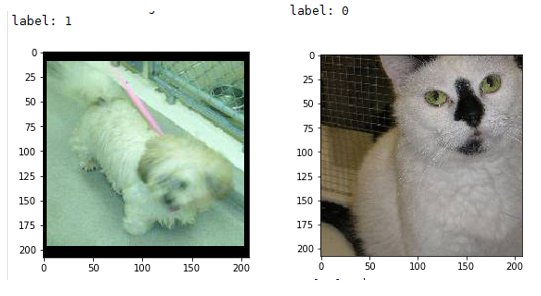Step 0:导入必要的库
import tensorflow as tfimport os
Step 1:获取图片文件名以及对应的标签
首先是读取给定路径下所有图片的名称以及对应的标签。os.listdir(file_dir)可以列出file_dir路径下所有文件名;str.split(sep='.')将字符串str以点(.)分割。
# you need to change this to your data directory train_dir = 'E:\data\Dog_Cat\train\'#Windows #train_dir = '/home/kevin/tensorflow/cats_vs_dogs/data/train/'#linux #获取给定路径下图片名及其对应的标签 def get_files(file_dir): ''' Args: file_dir: file directory Returns: list of images and labels ''' images=[] labels=[] for file in os.listdir(file_dir): name = file.split(sep='.') if name[0]=='cat': images.append(file_dir + file) labels.append(0) else: images.append(file_dir + file) labels.append(1) return images, labels
step3:分批次读取图片
由于图片数量太多,如果一次性将全部图片读入内存的话,可能会造成内存不够用的情况,因此需要分批次地将图片读入内存中。我们可以利用tensorflow的tf.train.slice_input_producer函数,利用队列的思想实现。
def get_batch(image, label, image_W, image_H, batch_size, capacity): ''' Args: image: list type label: list type image_W: image width image_H: image height batch_size: batch size capacity: the maximum elements in queue Returns: image_batch: 4D tensor [batch_size, width, height, 3], dtype=tf.float32 label_batch: 1D tensor [batch_size], dtype=tf.int32 ''' #将python的list数据类型转换为tensorflow的数据类型 #image = tf.cast(image, tf.string) #label = tf.cast(label, tf.int32) image = tf.convert_to_tensor(image, dtype=tf.string) label = tf.convert_to_tensor(label, dtype=tf.int32) # make an input queue 生成一个队列,shuffle=True即将图片打乱放入队列中 input_queue = tf.train.slice_input_producer([image, label],shuffle=True) label = input_queue[1] #获取label对应的队列 image_contents = tf.read_file(input_queue[0])#读取图片 image = tf.image.decode_jpeg(image_contents, channels=3)#解码jpg格式图片 ###################################### # data argumentation should go to here ###################################### #图片resize image = tf.image.resize_image_with_crop_or_pad(image, image_W, image_H) # if you want to test the generated batches of images, you might want to comment the following line. # 如果想看到正常的图片,请注释掉111行(标准化)和 126行(image_batch = tf.cast(image_batch, tf.float32)) # 训练时不要注释掉! #数据标准化 image = tf.image.per_image_standardization(image) #Creates batches of tensors in tensors. image_batch, label_batch = tf.train.batch([image, label], batch_size= batch_size, num_threads= 2, #线程数设置 capacity = capacity) #队列中最多能容纳的元素 #you can also use shuffle_batch # image_batch, label_batch = tf.train.shuffle_batch([image,label], # batch_size=BATCH_SIZE, # num_threads=64, # capacity=CAPACITY, # min_after_dequeue=CAPACITY-1) image_batch = tf.cast(image_batch, tf.float32) return image_batch, label_batch
首先,我们需要先把image和label转换成tensorflow的tensor相关数据类型;其次,我们需要将images和labels放入队列中,需要注意的是要设置shuffle=True将顺序打乱(默认shuffle=True)。然后通过tf.read_file和tf.image.decode_jpeg函数读取图片已经将其进行解码。接下来就是重新调整图片大小(通过crop或者pad的方式实现)和将图像归一化。最后就是利用tf.train.batch读取队列中batch_size个数的图像及其对应的标签。
测试:
接下来就是测试上面写的代码是否正确。
import matplotlib.pyplot as plt BATCH_SIZE = 4 CAPACITY = 256 #图片resize后的大小 IMG_W = 208 IMG_H = 208 #train_dir = '/home/kevin/tensorflow/cats_vs_dogs/data/train/' train_dir = 'E:\data\Dog_Cat\train\' image_list, label_list = get_files(train_dir) image_batch, label_batch = get_batch(image_list, label_list, IMG_W, IMG_H, BATCH_SIZE, CAPACITY) with tf.Session() as sess:#在会话中运行程序 i = 0 coord = tf.train.Coordinator()#线程协调者 threads = tf.train.start_queue_runners(coord=coord) try: # Check if stop was requested. while not coord.should_stop() and i<1: img, label = sess.run([image_batch, label_batch]) print(img[0,:,:,:]) # just test one batch for j in range(BATCH_SIZE): print('label: %d' %label[j]) plt.imshow(img[j,:,:,:]) plt.show() i+=1 except tf.errors.OutOfRangeError:#当读取完列队中所有数据时,抛出异常 print('done!') finally: #Request that the threads stop.After this is called, calls to should_stop() will return True. coord.request_stop() coord.join(threads)
首先是一些参数的设置,然后通过get_files和get_batch建立等下需要运行的Graph。由于读取图片时,涉及到队列已经多线程,因此需要tf.train.Coordinator来产生一个线程协调者,主要作用是协调线程是否终止(This class implements a simple mechanism to coordinate the termination of a set of threads.),更详细的用法可以参考下文的函数介绍和官网的说明。然后调用tf.train.start_queue_runners来启动之前定义好的Graph中所有的线程。
最后的效果:

函数注释:
1)np.hstack:
函数原型:numpy.hstack(tup)
tup可以是python中的元组(tuple)、列表(list),或者numpy中数组(array),函数作用是将tup在水平方向上(按列顺序)合并。
举例:
a=[1,2,3]
b=[4,5,6]
print(np.hstack((a,b)))
输出:[1 2 3 4 5 6 ]
2)transpose()
函数原型:numpy.transpose(a, axes=None)
作用:将输入的array转置,并返回转置后的array
举例:
>>> x = np.arange(4).reshape((2,2))
>>> x
array([[0, 1],
[2, 3]])
>>> np.transpose(x)
array([[0, 2],
[1, 3]])
注:
image_list = ["D:\1.jpg","D:\2.jpg","D:\3.jpg"] label_list = [1,0,1] temp = np.array([image_list, label_list]) print(temp) #输出: #[['D:\1.jpg' 'D:\2.jpg' 'D:\3.jpg'] # ['1' '0' '1']] temp = temp.transpose() print(temp) #输出: #[['D:\1.jpg' '1'] # ['D:\2.jpg' '0'] # ['D:\3.jpg' '1']] np.random.shuffle(temp) print(temp) #输出: #[['D:\2.jpg' '0'] # ['D:\1.jpg' '1'] # ['D:\3.jpg' '1']]
3)tf.cast
cast(
x,
dtype,
name=None
)
将x转换为dtype数据类型的张量。
举例:
x = tf.constant([1.8, 2.2], dtype=tf.float32) tf.cast(x, tf.int32) # [1, 2], dtype=tf.int32
4)tf.train.slice_input_producer
slice_input_producer(
tensor_list,
num_epochs=None,
shuffle=True,
seed=None,
capacity=32,
shared_name=None,
name=None
)
Produces a slice of each Tensor in tensor_list.
Implemented using a Queue -- a QueueRunner for the Queue is added to the current Graph's QUEUE_RUNNERcollection.
Args:
- tensor_list: A list of Tensor objects. Every Tensor in tensor_list must have the same size in the first dimension.
- num_epochs: An integer (optional). If specified, slice_input_producer produces each slice num_epochs times before generating an OutOfRange error. If not specified, slice_input_producer can cycle through the slices an unlimited number of times.
- shuffle: Boolean. If true, the integers are randomly shuffled within each epoch.
- seed: An integer (optional). Seed used if shuffle == True.
- capacity: An integer. Sets the queue capacity.
- shared_name: (optional). If set, this queue will be shared under the given name across multiple sessions.
- name: A name for the operations (optional).
Returns:
A list of tensors, one for each element of tensor_list. If the tensor in tensor_list has shape [N, a, b, .., z], then the corresponding output tensor will have shape [a, b, ..., z].
Raises:
- ValueError: if slice_input_producer produces nothing from tensor_list.
简单说来,就是生成一个队列,该队列的容量为capacity。
5)tf.read_file
作用:读取输入文件的内容并输出
6)tf.image.decode_jpeg
作用:将JPEG格式编码的图片解码成uint8数据类型的tensor。
7)tf.image.resize_image_with_crop_or_pad
resize_image_with_crop_or_pad(
image,
target_height,
target_width
)
将图片大小调整为target_height和target_width大小。若原图像比较大,则以中心点为裁剪。若原图像比较小,则在短边补零,使得大小为target_height和target_width。
8)tf.image.per_image_standardization
线性尺度变化,使得原图像具有零均值,单位范数( zero mean and unit norm)。
也就是计算(x - mean) / adjusted_stddev,其中mean是图像中所有像素的平均值,adjusted_stddev = max(stddev, 1.0/sqrt(image.NumElements()))。
adjusted_stddev是图像中所有像素的标准差,max作用为防止stddev的值为0。
9)tf.train.batch
batch(
tensors,
batch_size,
num_threads=1,
capacity=32,
enqueue_many=False,
shapes=None,
dynamic_pad=False,
allow_smaller_final_batch=False,
shared_name=None,
name=None
)
作用:Creates batches of tensors in tensors.即从输入的tensors获取batch_size大小的数据。
该函数是利用队列实现的。因此在使用的时候需要使用QueueRunner启动队列。
10)tf.train.Coordinator()
作用:线程协调者
任意一个线程可以调用coord.request_stop()来使所有线程停止。为了达到这一目的,每个线程必须定期检查coord.should_stop()。只要coord.request_stop()一被调用,那么coord.should_stop()马上返回True。
因此,一个典型的 thread running with a coordinator如下:
while not coord.should_stop(): ...do some work...
11)tf.train.start_queue_runners
作用:启动graph中所有的队列。
说明:
代码来自:https://github.com/kevin28520/My-TensorFlow-tutorials,略有修改
函数作用主要参考tensorflow官网。https://www.tensorflow.org/versions/master/api_docs/
本文中修改后的代码可以在这里下载:https://github.com/hjl240/dog_vs_cat